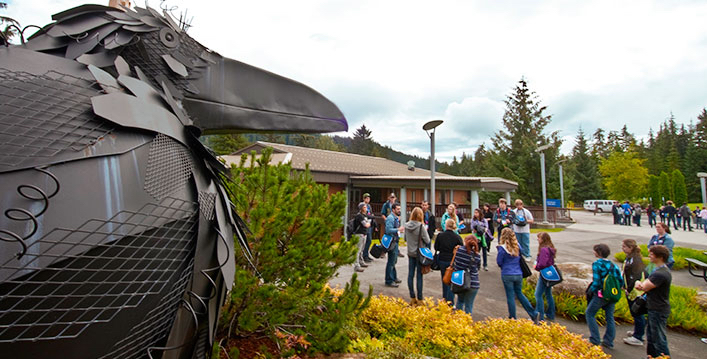Despite cutting $5.3 million from its budget, the new school year at University of Alaska Southeast is off to a good start, said chancellor Rick Caulfield.
“We’re excited as always to have our new freshmen on the campus here in Juneau and then, of course, we have a significant number of students in our Sitka and Ketchikan campuses, and also online,” he said.
The number of full-time equivalent students won’t be confirmed until October, but Caulfield said so far it’s down about five percent from last year’s figure of 1,772 students.
He said a number of factors contribute to the lower enrollment. One is the declining number of high school graduates in Alaska in recent years.
“All three of our universities — Fairbanks, Anchorage, Southeast — have seen declines in those 18-year-old freshman students, the more traditional age,” Caulfield said.
Another factor is the rising cost of tuition and fees. While UAS is affordable for a baccalaureate degree, Caulfield said the same is not true at the community college level. Most states have separate community college systems. UAS used to have that but the community college merged with the university in the mid-1980s.
“As tuition has gone up for the baccalaureate student, it’s gone up for the community college student. The net effect — the price of a one-year certificate or a two-year associate degree here in Alaska is about as high as you’ll find in the country,” Caulfield said.
He said University of Alaska System President Jim Johnsen is interested in finding ways to reduce the cost of these certificates and degrees, which are predominantly career and technical education.
Uncertainty could be another reason enrollment is down.
“As people read about the changes that are inevitably taking place in the university system and in the state’s economy, that has an impact on students’ choice,” Caulfield said.
UAS’s general fund budget this year is $24 million, which is about 10 percent lower than it was last year.
Accommodating that gap “was not easy as you can expect,” Caulfield said.
UAS reduced its work force across all three campuses by 32 positions — 22 through attrition, six layoffs and four term positions coming to an end.
“We made a major emphasis on trying to minimize the impact on the instructional side of our mission, in our classrooms and our labs, so we focused especially on reducing administrative overhead and reducing our fixed costs,” Caulfield said.
The school recently sold the Schaible House on Mendenhall Loop Road and it’s still looking to lease the Administrative Services Building, which houses the former bookstore.
UAS is constantly reviewing its academic programs and sometimes cuts programs that have lower enrollments, which can mean future savings. Caulfield said the school is moving toward eliminating its certificate in automotive technology and its associate of applied science in apprenticeship technology.
“And then we are continuing to look at other degree offerings as well for possible reduction or elimination,” he said.
Caulfield added, “Even as we are making these cuts, we’re reallocating resources into programs that we continue to believe are critical to Southeast Alaska.”
Like the Bachelor of Science in fisheries. It’s long been a program offered at University of Alaska Fairbanks, but he said a proposal to the Board of Regents is in the works to have UAS and UAF jointly offer the degree. To that end, UAS has already hired a new fisheries faculty member. UAS also added another new professor as it shifts from a general arts program to a greater focus on Northwest Coast art.
Board of Regents
UAS’s Juneau campus is hosting next week’s Board of Regents’ meeting Sept. 15-16 at the UAS Recreation Center.
Caulfield said major topics include a discussion on a single accreditation versus the current three separately accredited universities, and Strategic Pathways, which is a method and framework to reduce redundancy, cost costs and improve quality.
[Should UA’s three campuses combine into one? This report says no.]
Instead of taking public comment during the two-day meeting, the board is offering three alternative ways to give input.
One is through telephonic public testimony this Tuesday, Sept. 6, from 4 to 6 p.m. Members of the public from across the state can call 1-866-726-0757 and get two minutes to speak to the board.
The Board of Regents is also holding an in-person community gathering on Thursday, Sept. 15, from 5:30 to 7 p.m. at UAS Recreation Center’s Great Room, and the public can submit written feedback to the board through the university’s Strategic Pathways website.
Caulfield called these options “new approaches that are intended to provide a more effective way for board members to hear from the public about Strategic Pathways, about single accreditation, our budget situation and really whatever members of the public want to talk about.”
• Contact reporter Lisa Phu at 523-2246 or lisa.phu@juneauempire.com.

